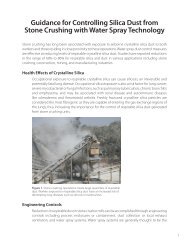Safety & Health in the Stone Crushing Industry - Occupational ...
Safety & Health in the Stone Crushing Industry - Occupational ...
Safety & Health in the Stone Crushing Industry - Occupational ...
Create successful ePaper yourself
Turn your PDF publications into a flip-book with our unique Google optimized e-Paper software.
25<br />
A.3 Keep<strong>in</strong>g Workers <strong>Health</strong>y<br />
<strong>Stone</strong> crush<strong>in</strong>g produces a lot of dust. Dust consists of particles,<br />
which are dispersed <strong>in</strong> <strong>the</strong> air and rema<strong>in</strong> <strong>the</strong>re for a while. It is<br />
generated from mechanical actions, such as stone crush<strong>in</strong>g, truck<br />
movement, etc. Although most dust particles can be seen with <strong>the</strong><br />
naked eye, some cannot be seen without <strong>the</strong> help of a microscope.<br />
These f<strong>in</strong>e dust particles can travel deep <strong>in</strong>to <strong>the</strong> lungs and have<br />
<strong>the</strong> potential to cause <strong>the</strong> most damage. A "dusty lung"<br />
(pneumoconiosis <strong>in</strong> medical terms) or severe chronic lung disease<br />
(called "chronic-obstructive pulmonary disease", COPD <strong>in</strong> medical<br />
terms) is a common hazard caused by to much exposure to dust.<br />
Several rocks such as granite and normal sand conta<strong>in</strong> a<br />
substance called "silica" <strong>in</strong> vary<strong>in</strong>g degrees, typically about 10 or<br />
20%. This substance causes even more severe lung disease when<br />
<strong>in</strong>haled as f<strong>in</strong>e, man-made particles ("silicosis" <strong>in</strong> medical terms).<br />
These f<strong>in</strong>e particles are typically found <strong>in</strong> <strong>the</strong> stone crush<strong>in</strong>g<br />
process. Scar tissue forms deep <strong>in</strong> <strong>the</strong> lungs and makes <strong>the</strong> lungs<br />
less efficient and less strong. Over time, even AFTER work <strong>in</strong> stone<br />
crush<strong>in</strong>g and <strong>the</strong> dust exposure has stopped, this destruction<br />
process <strong>in</strong> <strong>the</strong> lungs cont<strong>in</strong>ues and <strong>the</strong> worker will eventually die<br />
from <strong>the</strong> damage.<br />
Typical signs of lung damage by dust <strong>in</strong>clude difficulty breath<strong>in</strong>g,<br />
shortness of breath, wheez<strong>in</strong>g, constant cough<strong>in</strong>g, reddish or bluish<br />
color of ears and/or <strong>the</strong> lips. This difficulty <strong>in</strong> breath<strong>in</strong>g is often<br />
comb<strong>in</strong>ed with fatigue, loss of appetite, weakness.<br />
<strong>Stone</strong> dust cannot be avoided <strong>in</strong> stone crush<strong>in</strong>g. It is produced by<br />
<strong>the</strong> crush<strong>in</strong>g itself, <strong>the</strong> sort<strong>in</strong>g, <strong>the</strong> transport of gravel and also by<br />
vehicle movements over dusty roads. We can however reduce <strong>the</strong><br />
amount of dust that reaches <strong>the</strong> lungs. By eng<strong>in</strong>eer<strong>in</strong>g controls, <strong>the</strong> places where dust is generated<br />
can be encapsulated so <strong>the</strong> dust is not easily carried off by <strong>the</strong> w<strong>in</strong>d. Only after eng<strong>in</strong>eer<strong>in</strong>g and o<strong>the</strong>r<br />
controls have been used <strong>in</strong> all areas, personal protective equipment such as appropriate masks should<br />
be used. So-called Particulate Respirators Masks offer various amounts of protection depend<strong>in</strong>g on <strong>the</strong><br />
type of filter and <strong>the</strong> fit provided. Us<strong>in</strong>g a cloth to cover <strong>the</strong> nose and mouth is NOT really protect<strong>in</strong>g<br />
<strong>the</strong> worker.<br />
There is no good short-term solution to <strong>the</strong> problem.<br />
Appropriate masks that protect workers from dust are often<br />
hard to f<strong>in</strong>d <strong>in</strong> develop<strong>in</strong>g countries. Even if <strong>the</strong>y were<br />
available, <strong>the</strong> very high amount of dust would force <strong>the</strong><br />
workers to change <strong>the</strong> masks or filters several times per<br />
day. In addition, <strong>the</strong> masks are often uncomfortable,<br />
specifically when one works <strong>in</strong> a hot climate.<br />
The best solution is <strong>the</strong>refore to REDUCE <strong>the</strong> amount of<br />
dust that is be<strong>in</strong>g released <strong>in</strong>to <strong>the</strong> ambient air. This can be<br />
done by:<br />
• Enclos<strong>in</strong>g <strong>the</strong> dust sources and processes<br />
• Ventilate with a local exhaust system near <strong>the</strong><br />
generat<strong>in</strong>g source<br />
• Spray<strong>in</strong>g water at <strong>the</strong> source of dust dispersion







